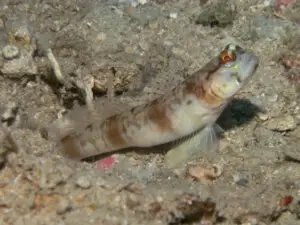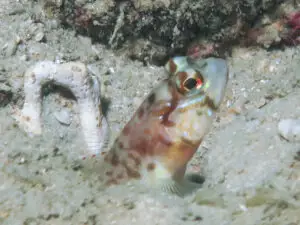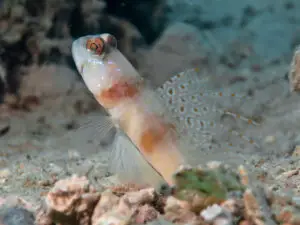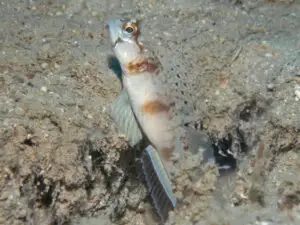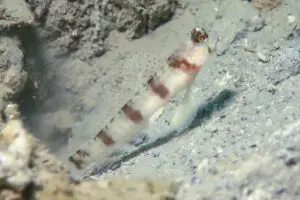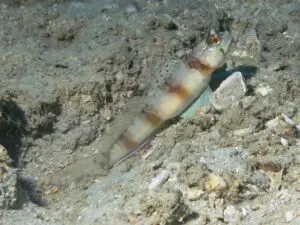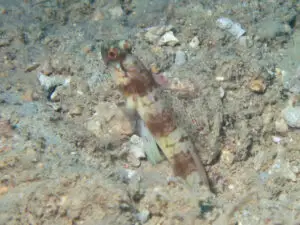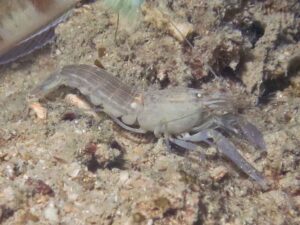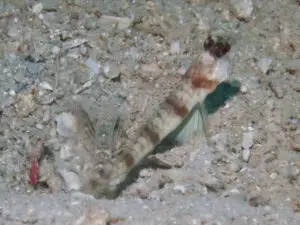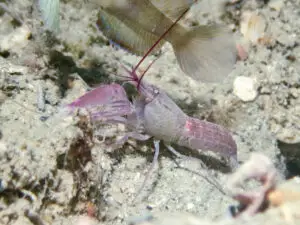Longspine Shrimpgoby
Amblyeleotris macronema
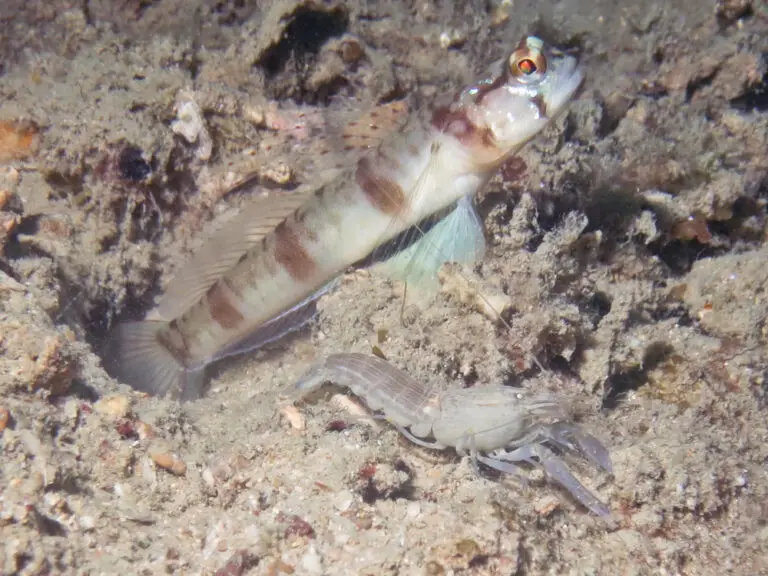
Longspine Shrimpgoby
Amblyeleotris macronema
Polunin and Lubbock, 1979
Description
Body Design
This is a small goby growing to 8 cm in length. The body is grey with four brown bars. The intervening spaces are pale ventrally, and darker dorsally with ill-defined dark grey-brown pattern of blotches. There is a fifth, less defined bar at the base of the tail.
Head Design
The head shows a brown mark at the corner of the mouth and often a strongly marked dark brown line running back from the eye. There are scattered iridescent blue spots and lines from the eye to the operculum.
Fin Design
The first dorsal fin has pale blue outlined red spots arranged regularly along the spines. This fin takes two forms (perhaps sexual). In one form the rays do not extend beyond the fin margin and in the other the third, fourth and fifth spines are greatly elongated. The second dorsal fin is rectangular and has orange spots along the edge.
The anal fin is beige proximally and clear distally, the two areas being separated by an iridescent pale blue line and a red line. The pelvic fin is blue-green. The pectoral fins are clear. The caudal fin is translucent brown with a darker extension of the caudal peduncle marking on the lower margins.
Influence of habitat On darker sand the colour of the pigmented areas is intensified and more reliable. Darker pigmented individuals have dark facial lines, dark lines between the body bars and sometimes a dark face.
Diagnostic features
The red spotting and elongated spines on the first dorsal fin, which is usually held erect, are the best identification features.
Similar Species
Underwater this species is very hard to distinguish from A stenotaeniata. A stenotaeniata has similar body markings but does not have the red spots or extended rays on the dorsal fin. They occupy a similar habitat and may live in adjacent but separate areas of the reef.
A macronema has a superficial similarity to others in its genus. The dorsal fin features are diagnostic and fortunately, this is usually elevated enough to see.
Dark individuals have a dark line behind the eye and dark lines between the body bars. They may resemble A gymnocephala but are distinguished by the distinctive fins and body design of A macronema.
Taxonomy
This species was erroneously redescribed as A neumanni by Randall and Earle in 2006. The image in Fishbase of A neumanni should be A macronema.
Natural History
Habitat
Found in silty substrates with coral rubble at 15 to 30 m in conditions of poor visibility (< 5 m) at the base of sheltered fringing reefs on islands within the Great Barrier Reef lagoon.
Behaviour
This is an uncommon fish but in suitable conditions of substrate and depth, it may be found in reasonable concentrations. It is usually perched vertically on the largest nearby piece of coral rubble with its distinctive dorsal fin extended, guarding the burrow entrance. It withdraws quickly when approached but returns to its post after a short interval. Fins are raised most of the time, possibly a species characteristic or in challenge to other fish of their species.
Burrow sharing
We have seen A macronema emerge from a burrow with the Larson’s shrimpgoby, Stonogobiops larsonae (see photo).
This would not be a permanent arrangement but there was no animosity or challenging behaviour.
We have photographed a pair of Threadfin Dartfish (Ptereleotris hanae) sheltering in the burrow of Longspine Shrimpgoby. Remarkably the attendant shrimp, a Violet Shrimp, continued to work in the burrow entrance while the invaders were inside.
Burrow proximity and Shrimp associations
In our experience, the burrows of the two similar species A macronema and A stenotaeniata will occur in the same habitat on the same reef usually clustering in single species patches that do not overlap. They associate with different shrimps so this may indicate some subtle variation in the substrate.
Grooming by the partner shrimp
This is one species in which we have seen the partner shrimp, a Grey Shrimp, cleaning the goby.
Distribution
Published distribution: Type description from Lizard Island, Australia. A neumanni described from New Britain, PNG
Our Records: Australia: Low Isles and Fitzroy Island Queensland.
Associated Shrimp species
Associated Shrimps (three shrimps)
Grey Snapping Shrimp, Alpheus species 5
Red Speckled Snapping Shrimp, Alpheus species 10
Violet Snapping Shrimp, Alpheus fenneri (visual records)

